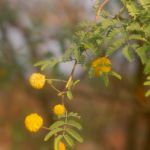| Common Name: |
Cassie |
| Other Names: |
Prickly Moses |
| Botanical Name: |
Acacia farnesiana |
| Genus: |
Acacia |
| Family: |
Mimosaceae |
| Native Location: |
Tropical America |
| Cultivation: |
Well-drained, neutral to acid soil in full sun. No regular pruning is required. To keep pot plants bushy, pinch out side shoots. To control size, cut back hard after flowering, removing two-thirds of the main growths. Wattles dislike disturbance, forming long taproots that are sensitive to damage. Repot and transplant only when necessary; trees may take a year to recover. Prone to spider mite and root mealybug when grown under cover. Tortrix moth caterpillars may damage the leaves and new shoots. Acacia species are noxious weeds in part of Australia, where sale and introduction are illegal. |
| Propagation: |
By seed sown in spring at 21°C (70°F): seedshave hard coats, which should be nicked and soaked in water for 24 hours before sowing; by semi-ripe cutting of lateral shoots in late summer 16-18°C (61-64°F). |
| Harvest: |
Bark and leaves (A. catechu) are cut as required for use in infusions and powders. Flowers (A. farnesiana) are picked as they open and are dried for use in infusions and baths, or distilled for oil. Seeds and pods are collected when ripe and pressed for oil. Resin (A. senegal) is scraped from the trunk and branches in the winter, after the rainy season, as it oozes from the bark; incisions are sometimes made to increase the quantity. Unhealthy trees are the best source of resin, which is processed into powder or dissolved in water. |
| Height: |
3-7m (10-22ft) |
| Width: |
3-5m (10-15ft) |
| Hardiness: |
Min. 7°C (45°F) |
| Parts Used: |
Bark, flowers, pods, seeds. |
| Properties: |
An aromatic, stimulant herb that relieves tension and contains insecticidal compounds (in the flowers). It is reputedly aphrodisiac. |
| Medicinal Uses: |
Internally for diarrhea and skin complaints (bark). Externally in baths for dry skin (flowers). |
| Culinary Uses: |
Ripe seeds are pressed for cooking oil. Young, acid leaves flavor chutneys. |
| Economic Uses: |
Bark and pods yield a black dye. Flower extracts are insecticidal. Gum arabic is widely used in the food industry in desserts and candy. Flowers are added to potpourris. Solid extract from flowers, "cassie absolute", has a fine violet fragrance, often used in perfumery. |
| Bibliography: |
Encyclopedia of Herbs by Deni Brown Copyright © 1995, 2001 Dorling Kindersley Limited Pp 97-98 |

